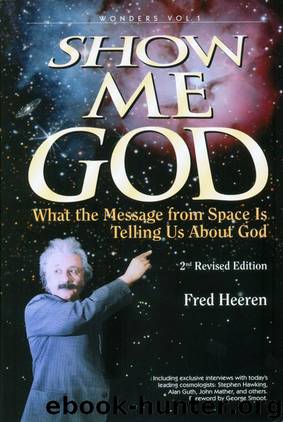Show Me God by Fred Heeren

Author:Fred Heeren [Heeren, Fred]
Language: eng
Format: epub, mobi
Tags: Science
ISBN: 9781885849526
Publisher: Day Star Publications
Published: 2012-08-22T23:00:00+00:00
Purposeful Selection No. 8:
Slight Excess of Matter over Antimatter
Antimatter sounds like something that was invented especially by the writers of Star Trek, a handy sci-fi plot device that is occasionally employed to threaten our heroes with annihilation. However, English quantum physicist Paul Dirac could not avoid the existence of "antiparticles," try as he might, when in 1929 he made calculations that combined certain elements of special relativity and quantum mechanics. He concluded that whenever energy was converted to mass, matter must be created in equal amounts of matter and antimatter. Each atomic particle must then have its opposite. Protons must have antiprotons as their antimatter counterpart. If there are electrons, then there must be anti-electrons, now called positrons. Each antiparticle has exactly the same mass, behavior, etc., as its counterpart—except that its electrical charge is opposite.
The idea of converting mass to energy is easy enough to grasp: We see it when we see the sun shine or a candle burn. In the case of candles, the amount of mass that is actually converted to energy is measured in billionths of the original mass. Nuclear fusion (as in a hydrogen bomb or the sun) converts a half of one percent of the mass into energy. But if matter and antimatter were ever to come into contact, a perfectly efficient conversion of matter into energy would result; that is, 100 percent of the matter would be converted into energy. Obviously, scientists would like to find and control such an efficient energy source, just as the Star Trek writers used antimatter to fuel their spaceships.
Antimatter was found—and the proposal on paper entered the realm of observational science—in 1932. Caltech's Carl Anderson detected a particle in his cloud chamber that had the same mass as an electron—but it was positively rather than negatively charged. He photographed its vapor trail, showing that it took the path of a positively charged particle. Such positrons are thought to be rare, probably resulting from occasional collisions with high energy cosmic particles in the upper atmosphere. Dirac and Anderson later received Nobel prizes for their work, as did the physicists in the 1950s who used a particle accelerator at the Lawrence Berkeley Laboratory to generate their own antimatter. By creating high energy collisions between protons, Emilio Segre and Owen Chamberlain produced pairs of protons and antiprotons, demonstrating that when energy is converted into matter, an equal amount of antimatter is created.
A puzzling question remained: Why didn't the original creation of matter result in equal amounts of matter and antimatter throughout the universe? Some invoked the anthropic principle, "explaining" the phenomenon simply by saying that the universe simply must be this way or we wouldn't be here to talk about it. If matter and antimatter had been produced in equal quantities, as Dirac's calculations showed we should expect, a tremendous annihilation would have occurred. Our universe would consist of a vast soup of photons, which, if it lasted as long as our actual universe, would mean that the microwave background radiation would be about all that there would be.
Download
This site does not store any files on its server. We only index and link to content provided by other sites. Please contact the content providers to delete copyright contents if any and email us, we'll remove relevant links or contents immediately.
| Aeronautics & Astronautics | Astronomy |
| Astrophysics & Space Science | Comets, Meteors & Asteroids |
| Cosmology | Mars |
| Solar System | Star-Gazing |
| Telescopes | UFOs |
Tools of Titans by Timothy Ferriss(8303)
Turbulence by E. J. Noyes(7977)
Secrets of Antigravity Propulsion: Tesla, UFOs, and Classified Aerospace Technology by Ph.D. Paul A. Laviolette(5332)
Astrophysics for People in a Hurry by Neil DeGrasse Tyson(5151)
Room 212 by Kate Stewart(5070)
Design of Trajectory Optimization Approach for Space Maneuver Vehicle Skip Entry Problems by Runqi Chai & Al Savvaris & Antonios Tsourdos & Senchun Chai(5037)
Pale Blue Dot by Carl Sagan(4952)
The David Icke Guide to the Global Conspiracy (and how to end it) by David Icke(4655)
A Journey Through Divination and Astronomy by Publishing Pottermore(4363)
Goodbye Paradise(3761)
Apollo 8 by Jeffrey Kluger(3665)
COSMOS by Carl Sagan(3586)
Losing the Nobel Prize by Brian Keating(3518)
The Five People You Meet in Heaven by Mitch Albom(3515)
How to Read Water: Clues and Patterns from Puddles to the Sea (Natural Navigation) by Tristan Gooley(3430)
Brief Answers to the Big Questions by Stephen Hawking(3392)
How to Read Nature by Tristan Gooley(3290)
The Order of Time by Carlo Rovelli(3162)
A Brief History of Time by Stephen Hawking(2991)
